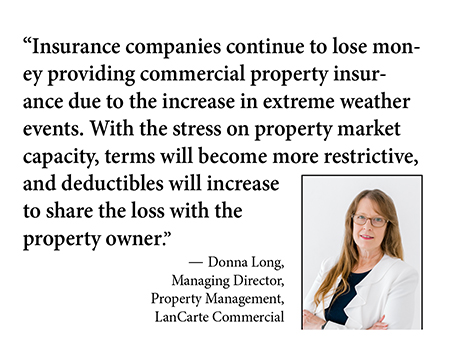By Donna Long, managing director, property management, LanCarte Commercial
The role of property managers is to safeguard and enhance the value of our clients’ assets. And in today’s evolving landscape, commercial property managers navigate challenges such as extreme weather events, rising insurance costs, regulatory changes and environmental sustainability. Addressing these challenges effectively requires a proactive, quality-focused approach to ensure smooth operations and long-term profitability.
Extreme weather events — hurricanes, floods, tornadoes — are more frequent and severe than ever before. They pose increasingly significant risks to commercial properties, requiring greater expertise in risk management strategies. Weather-related or other destructive events can lead to significant business interruptions, so property managers play a vital role in developing and implementing effective emergency response plans that align with insurance requirements and expectations. These plans include:
- Conducting risk assessments at each property at least annually to identify location-specific vulnerabilities and to validate current protocol effectiveness
- Develop building-specific emergency plans to address local jurisdictional requirements, potential security, weather or other specific events with the intent of keeping occupants safe
- Provide tenants with floor plans outlining the basic property life safety elements such as egress points, emergency lighting, refuge areas, meeting points, fire-safe rooms, tornado shelters, etc.
- Have a process in place to regularly inspect egress routes, stairwells, emergency lighting and fire protection systems.
- Conduct drills periodically to assess readiness and to identify process-improvement opportunities.
Having a network of trusted contractors, structural engineers and other service providers on standby is essential for rapid repair response and minimized operational interruptions. Strong relationships with local emergency services and disaster response teams allow for quicker deployment of resources and support during a crisis. Effective communication with all stakeholders — tenants, property owners, emergency responders — ensures that everyone is informed, expectations are managed and appropriate actions are being taken.

After a severe weather event, structural engineers and contractors assess structural damage, conduct safety inspections and initiate repairs and restorations that comply with new federal regulations and local building codes. Regulations evolve often, requiring property managers to be up to date through regular training, consultations with legal and compliance experts and incorporation of new standards into property maintenance and management practices.
Proactive adaptation to regulatory changes not only ensures compliance but also enhances property value. Adhering to the latest energy efficiency codes can result in cost savings and attract tenants who prioritize sustainability. Implementing green building practices, such as energy-efficient systems, water-saving fixtures and sustainable materials, reduces environmental impact and operational costs.
For small businesses that are particularly vulnerable to extreme weather events and can be devastated by costs of mitigation, proposed legislation has been introduced at the Congressional level. House of Representatives Bill 2966, also known as the “PREPARE Act,” if passed, will aid property owners in their mitigation efforts to reduce the impacts of these severe weather events. Economic injury disaster loans will be disbursed to small businesses for protection of real estate, equipment, inventory, supplies and materials. This bill is currently moving through the legislative and committee processes and would be a tremendous resource for protecting infrastructure and property values if passed.
As insurance costs continue to rise, property managers collaborate with insurers to secure comprehensive and cost-effective policies. By reducing the frequency and severity of claims, property owners can present themselves as lower risk clients to insurance companies by implementing effective preventative and safety measures. Maintaining detailed property records with thorough risk assessments can help demonstrate that a property is well-maintained and prepared for potential risks, thereby leading to more favorable insurance terms and lower premiums.
The types of coverage recommended for properties in areas prone to extreme weather or natural disasters vary depending on owner versus tenant status. Property owners should have coverage that includes floods, earthquakes and/or named storms. Coverage can be added for loss of rents on these policies, which can be collected from the insurance company if a tenant is forced to move out during repair or construction.
For tenants, insurance policies are based on operations and lease requirements. At minimum, tenants should carry commercial general liability, business interruption and workers’ compensation policies. Other coverages to consider are environmental liability, commercial, auto and umbrella liability.
Stephen Santellan, vice president and commercial lines team leader at IMA Financial Group Inc., a financial services company specializing in retail and wholesale insurance, risk management and wealth management, explains insurance companies’ perspsective. “Insurance companies take a holistic view of the risk,” he says. “They are looking for the best quality of buildings to insure.”
To reduce premiums, there are specific upgrades and maintenance practices that insurers will consider when rewarding lower rates, including:
- Regular roof inspections
- Capital budget for investing in the property’s quality
- Hail-resistant roof
- Adequately sprinklered buildings
- Water mitigation and emergency response plans and occupied buildings with tenants that match the building’s purpose
“Property owners willing to take on more risk should consider higher deductibles to control costs; however, it is important that the deductible accepted is approved by the lenders of the property,” says Santellan. “Additionally, property captive programs should be considered, although most success is usually found for best-of-the-best portfolios that have a large spread of risk and newer properties.”
Insurance companies continue to lose money providing commercial property insurance due to the increase in extreme weather events. With the stress on property market capacity, terms will become more restrictive, and deductibles will increase to share the loss with the property owner.
Managing commercial properties in today’s environment involves a multifaceted approach to risk management and value enhancement. The goal of property managers is to ensure that commercial properties are not only well-maintained but also prepared for current and future challenges. Through diligent management, strategic risk mitigation and a commitment to sustainability, property managers can safeguard their clients’ investments and contribute to the long-term success of their properties.
LanCarte Commercial is a commercial real estate firm specializing in investment, brokerage and property management with offices in Fort Worth and Dallas.


